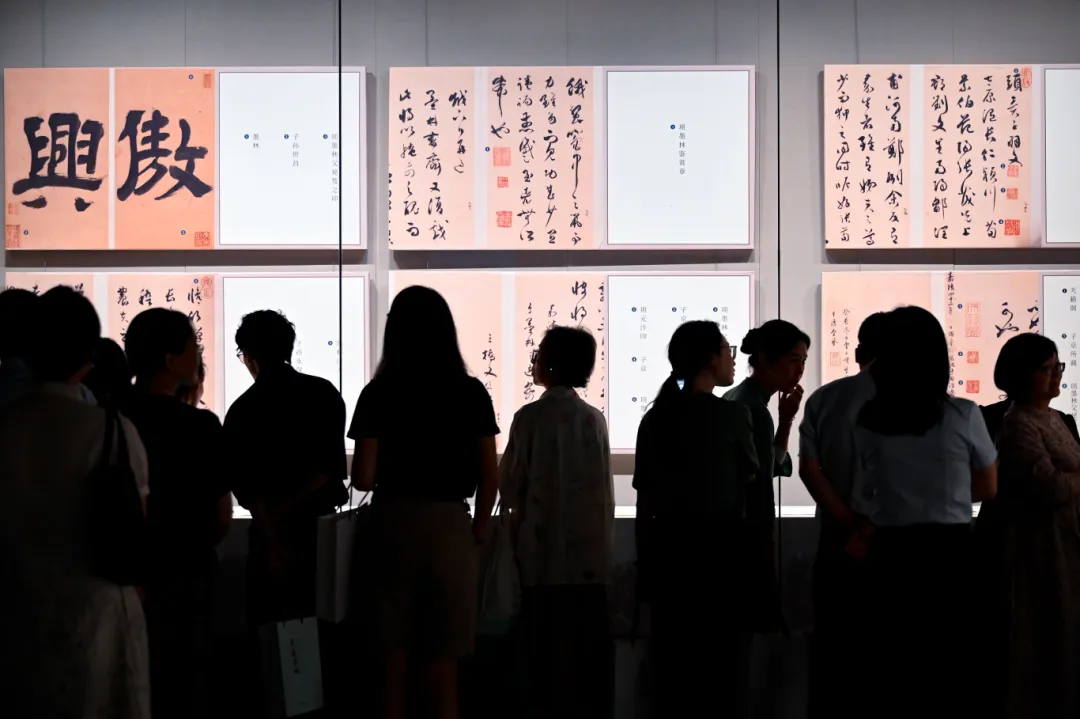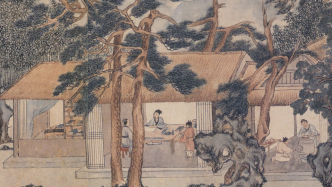
"A Tianlai Pavilion represents half of the history of Chinese calligraphy and painting" - this evaluation that has been passed down to this day reveals the extraordinary achievements of Xiang Yuanbian, a great collector in the Ming Dynasty.
The imperial edict written by Emperor Xiaozong of Song, Zhao Shen, the only portrait of Xiang Yuanbian handed down to the present day, the authentic works of Wen Zhengming... these old collections of Tianlai Pavilion scattered across the country, on the occasion of the 500th anniversary of the birth of Ming Dynasty collector Xiang Yuanbian, have been "returned home" for the first time in a large scale, and returned to Jiaxing, Zhejiang, where Tianlai Pavilion is located. "Echoes of Heaven - Special Exhibition of Calligraphy and Painting for the 500th Anniversary of Xiang Yuanbian's Birth" was recently exhibited at Jiaxing Museum, opening a cultural chapter in Jiaxing's commemoration of this "first private collector in ancient and modern times."
A Tianlai Pavilion: Half of the History of Chinese Painting and Calligraphy
Xiang Yuanbian (1525-1590), courtesy name Zijing and pseudonym Molin Jushi, was from Jiaxing. This "top" figure in the Ming Dynasty collection world had contradictory identity labels: he was born into a prominent family, but he ran a pawnshop as a businessman and had no intention of taking the imperial examination; he had a lot of money, but he devoted his life's assets to collecting calligraphy and paintings. With his extraordinary vision and strong financial resources, Xiang Yuanbian built a world-class collection system in a few decades. His Tianlai Pavilion collection includes works by more than 460 calligraphers and painters from past dynasties, totaling more than 1,400 pieces (some say 2,190 pieces), from Wang Xizhi and his son in the Eastern Jin Dynasty to Shen Zhou and Wen Zhengming in the Ming Dynasty, spanning a thousand years of calligraphy and painting history. The Palace Museum currently has a collection of about 4,600 pieces of calligraphy and paintings, and Xiang alone collected nearly half of them. The quality is even more amazing - Wang Xizhi's "Kuaixue Shiqing Tie", Huaisu's "Kusun Tie", Song Huizong's "Qinghe Tie" and Mi Fu's "Qinghe Tie" were all collected here.

Exhibition site. Photo courtesy of Jiaxing Museum
Stepping into the exhibition hall of Jiaxing Museum, it seems as if time has gone back 500 years. In 1525, when Xiang Yuanbian was born at the southern foot of Pingshan Mountain in Jiaxing, no one would have thought that this merchant's son would build the most brilliant private treasure house in the history of Chinese collection.
"One Tianlai Pavilion holds half of the history of Chinese calligraphy and painting." Tianlai Pavilion is the name of Xiang Yuanbian's library. According to research, the collection of Tianlai Pavilion covers more than 1,400 pieces of calligraphy and painting treasures, spanning the thousand-year art history from the "Two Wangs" of the Eastern Jin Dynasty to the "Four Masters of the Ming Dynasty," and brings together works by more than 460 calligraphers and painters from all dynasties.
This special exhibition was jointly created by Jiaxing Museum, Tianjin Museum, Shanghai Museum and other 16 cultural and museum institutions, and exhibited 50 precious cultural relics and 55 imitation works. Among them, there are 5 national first-class cultural relics and 22 second-class cultural relics, creating the largest-scale concentrated display of Tianlai Pavilion's old collection in more than 400 years.
"The Scroll of 'Song Xiaozong Zhao Shen's Reply to Yu Yunwen' in the Sichuan Museum is of the most special significance in the exhibition." The curator of the special exhibition introduced that this national treasure with a history of nearly a thousand years not only has the handwriting of Song Xiaozong, but also has many collector's seals such as Wen Zhengming and Xiang Yuanbian at the beginning and end of the scroll.

▲Handwritten edict of Emperor Xiaozong of the Southern Song Dynasty, Zhao Shen (partial)
What is amazing is the double "Jiaxing imprint" of this work: Song Xiaozong is the only emperor born in Jiaxing in history, and Xiang Yuanbian is a native of Jiaxing. One cultural relic connects two historical figures of Jiaxing who were separated by hundreds of years, forming a dialogue across time and space.

Handwritten edict of Emperor Xiaozong of the Southern Song Dynasty, Zhao Shen (partial) (Sichuan Museum)
In the center of the exhibition hall, the "Portrait of Xiang Yuanbian, Horse of the Ming Dynasty" collected by the Shanghai Museum attracts people to stop and take a look. This is the only standard portrait of Xiang Yuanbian in existence. It uses light ink to outline the outline and color rendering, vividly showing the wise image of this Confucian businessman.

Portrait of Xiang Yuanbian, a Ming Dynasty Horse Painting
"Xiang Yuanbian did not write a single book, and the most impressive things about him are the various seals he stamped on masterpieces of past dynasties." Some art historians believe that in many Ming and Qing notes, this businessman without any official title was often ridiculed by literati as a pretentious businessman. However, when the audience stands in front of the "Ming Xiang Yuanbian Bamboo and Rock Standing Scroll" and sees the landscape painting created by Xiang Yuanbian himself, his artistic attainments far exceed historical prejudices.

Ming Dynasty Xiang Yuanbian "Bamboo and Rock Scroll" Liaoning Provincial Museum Collection
The exhibition carefully sorts out four cultural contexts. "Xiang Yuanbian and Tianlai Pavilion" shows his life and collection philosophy, "Tianlai Pavilion's Unparalleled Collection" presents the calligraphy and painting system from the Eastern Jin Dynasty to the Ming Dynasty, "Tianlai Pavilion's Historical Contribution" reveals its profound influence on masters such as Dong Qichang, and "Transformation of Tianlai Pavilion's Collection" explores the contemporary expression of traditional art.
In the "Xiang Yuanbian's Friends Circle" section, the masterpieces of Ming Dynasty masters such as Wen Zhengming, Chen Chun, and Zeng Jing shine together. A fan with a seven-character poem in running script by Wen Zhengming bears witness to the key friendship on Xiang Yuanbian's artistic path - when the young Xiang Yuanbian first met Wen Zhengming, this one of the "Four Masters of the Ming Dynasty" was already in his twilight years, but he still carefully guided this young man who was passionate about calligraphy and painting. According to statistics, Xiang Yuanbian collected at least 30 paintings and calligraphy by Wen Zhengming, many of which were specially created at his invitation.



▲Wen Zhengming of the Ming Dynasty, "Handscroll of Ming Pei in front of the Window" (partial) (Collection of Juntao Art Academy)
The Ming Dynasty "Window Ming Pei Hand Scroll" was created when Wen Zhengming happened to pass by his good friend Tang Zhen's garden pavilion and stayed there for a day. During the conversation, he mentioned the story of Wang Huizhi of the Eastern Jin Dynasty who liked to plant bamboo in his garden. Tang Zhen then offered silk to ask for a painting, and Wen Zhengming painted this painting after returning home. Wen Zhengming loved bamboo, and he compared the "squeaking" sound of the bamboo in front of the window swaying in the wind to the sound of the jade pendant, which is the origin of the four words "Window Ming Pei".
The picture is surrounded by mountains and rivers, with green pines and cypresses. Under the towering ancient trees, there are several thatched cottages. In the cottage, a man is kneeling on the ground, concentrating on reading a painting. A plank bridge lies across the stream, and a man is walking slowly back with a cane.

Ming Dynasty Wen Zhengming's seven-character poem in running script (Pinghu Museum)
Wen Zhengming's "Seven-Character Poem in Running Script" has a tight and unconstrained structure, and his brushwork is vigorous and unrestrained, with various tilts and postures, striving for danger and uniqueness. Chen Chun, a representative figure of Ming Dynasty freehand flower and bird painting, has a pine and stone scroll with elegant ink and simple and vigorous brushwork.

Ming Chen Chun Pine and Stone Scroll (Collection of Juntao Art Academy)
Cultural Hub: Tianlai Pavilion that Shaped the Art Ecology of the Ming Dynasty
Tianlai Pavilion was not only a treasure house, but also a cultural reception hall in Jiangnan during the Ming Dynasty. "The elegant people in the country, when passing through Jiahe, must visit Yuanbian and climb the so-called Tianlai Pavilion" - the record of Jiahe Zhengxianlu describes the grand occasion at that time.
In stark contrast to the famous Ming Dynasty book collection pavilion, which was closed to the public with only a dozen people entering in hundreds of years, Xiang Yuanbian was open to his collection. In an environment where many collectors are "self-centered and stingy, and enjoy their works for themselves", this selflessness is particularly precious.

The "Tianlai Pavilion" seal in "Jiuhuatie". (Note: not a work in this exhibition)
A replica of Qiu Ying's "Appreciating Antiques in a Bamboo Courtyard" in the exhibition hall recreates the scene of the literati gathering at that time. This one of the "Four Masters of the Ming Dynasty" was hired by Xiang Yuanbian to be the director of Tianlai Pavilion for more than ten years and became Xiang Yuanbian's largest art sponsor.
Tianlai Pavilion has a collection of about 50 paintings by Qiu Ying, including one of the ten famous paintings handed down from ancient times, "Spring Dawn in the Han Palace". The most touching thing is the origin of Dong Qichang and Tianlai Pavilion. Dong Qichang, who was in his twenties, once studied in Jiaxing and became a fellow student of Xiang Mu, the son of Xiang Yuanbian. Xiang Yuanbian appreciated his talent and gave him his collection for him to learn and copy, which became a turning point in Dong Qichang's artistic career.

A scroll of Hu Erxun's portrait painted by Zeng Jing in the seventh year of the Tianqi reign of the Ming Dynasty. (Collection of Deqing County Museum)
"I traveled to Li (Jiaxing) for three to five years and found all the calligraphy works of the Jin and Tang dynasties collected by Xiang Taixue Zijing. Only then did I realize that my previous efforts had been in vain." Dong Qichang recalled in his later years in "Mochanxuan Shuo". Professor Fan Jingzhong of the China Academy of Art emphasized at this commemorative event: "Xiang Yuanbian shaped the culture of Jiaxing. In a sense, he shaped the culture of the Ming Dynasty."
During the exhibition, Jiaxing University held a cultural exchange activity titled "Revival of the Sound of Nature: 500 Years of Xiang Yuanbian's Collection and the Echo of Traditional Art Spirit". More than 30 scholars from institutions such as the China Academy of Art and the Central Academy of Fine Arts conducted in-depth discussions on topics such as "the value and significance of Xiang Yuanbian's collection". Professor Fan Jingzhong of the China Academy of Art said in his speech: "Xiang Yuanbian's collection is one of the cornerstones of Chinese calligraphy and painting research. It is these collections that allow us to confidently explain the exquisiteness of Chinese painting and its contribution to world civilization."
Jiaxing also released four research results simultaneously: "Jiaxing has many talented people - Jiaxing Celebrity Directory", "Jiaxing Calligraphy and Painting Literature Collection", "Jiaxing Calligraphy and Painting Celebrity Directory" and "Jiaxing Xiang Family Collection". It is reported that the exhibition will last until July 27.
